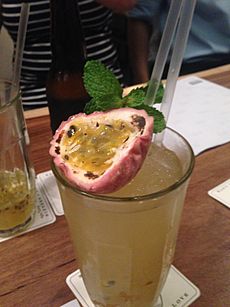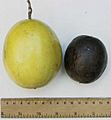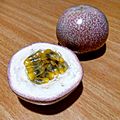Passionfruit facts for kids
Quick facts for kids Passion fruit |
|
|---|---|
 |
|
| Ripe purple type from Australia and its cross section | |
| Scientific classification | |
| Kingdom: | |
| Division: | |
| Class: | |
| Order: | |
| Family: | |
| Genus: | |
| Species: |
P. edulis
|
| Binomial name | |
| Passiflora edulis Sims
|
|
The Passionfruit (also spelled passion fruit) is a small, spherical fruit. It is purple when ripe, and green when not ripe. The fruit contains many small, black seeds covered with the fruit's flesh. It is tart and sweet. The seeds can be eaten on their own or used for various cooking recipes.
Contents
Cultivation
Passion fruit is widely grown in tropical and semitropical regions of the world. Within the United States, it is grown in Florida and California. They generally have to be protected from frost, although certain cultivars have survived light frosts after heavy pruning of affected areas.
Pollination
The flower of the yellow-fruited form of the passion fruit plant is self-sterile, while that of the purple-fruited form is self-compatible. Pollination of flowers is most effective when done by the carpenter bee. There are three types of yellow passion fruit flowers, classified by curvature of style. To help assure the presence of carpenter bees, place decaying logs near the vines, which provide shelter for the bees.
Uses
Passion fruit has a variety of uses related to its appealing taste as a whole fruit and juice.
- In Australia and New Zealand, it is available commercially both fresh and tinned. It is added to fruit salads, and fresh fruit pulp or passion fruit sauce is commonly used in desserts, including as a topping for pavlova (a regional meringue cake) and ice cream, a flavouring for cheesecake, and in the icing of vanilla slices. A passionfruit-flavored soft drink called Passiona has also been manufactured in Australia since the 1920s. It can be used in some alcoholic cocktails.
- In Brazil, the term maracujá applies to passion fruit (maracujá azedo, or "sour") and granadillo (maracujá doce, or "sweet"). Passion fruit mousse is a common dessert, and passion fruit pulp is routinely used to decorate the tops of cakes. Passion fruit juice, ice pops and more recently soft drinks are also popular. When making caipirinha, one may use passion fruit instead of lime.
- In Colombia, it is one of the most important fruits, especially for juices and desserts. It is widely available all over the country and three kinds of "maracuyá" fruit may be found.
- In the Dominican Republic, where it is locally called chinola, it is used to make juice and Fruit preserves. Passion fruit-flavored syrup is used on shaved ice, and the fruit is also eaten raw, sprinkled with sugar.
- In East Africa, passion fruit is used to make fruit juice and is commonly eaten as a whole fruit.
- In Hawaii, where it is known as liliko'i, passion fruit can be cut in half and the seeds scooped out with a spoon. Lilikoi-flavoured syrup is a popular topping for shave ice. It is used as a dessert flavouring for malasadas, cheesecakes, cookies, ice cream and mochi. Passion fruit is also favoured as a jam or jelly, as well as a butter. Lilikoi syrup can also be used to glaze or to marinate meat and vegetables.
- In India, the government of Andhra Pradesh started growing passion fruit vines in the Chintapalli (Vizag) forests to make fruit available within the region. The fruit is eaten raw, sprinkled with sugar and is also used to make juice.
- In Indonesia, there are two types of passion fruit (local name: markisa), white flesh and yellow flesh. The white one is normally eaten straight as a fruit, while the yellow variety is commonly strained to obtain its juice, which is cooked with sugar to make thick syrup.
- In Mexico, passion fruit is used to make juice or is eaten raw with chilli powder and lime.
- In Paraguay, passion fruit is used principally for its juice, to prepare desserts such as passion fruit mousse, cheesecake, ice cream, and to flavour yogurts and cocktails.
- In Peru, passion fruit has long been a staple in homemade ice pops called "marciano" or "chupetes". Passion fruit is also used in several desserts, especially mousses and cheesecakes. Passion fruit juice is also drunk on its own and is used in ceviche variations and in cocktails, including the Maracuyá sour, a variation of the Pisco sour. (Granadilla, or "sweet") can be eaten raw.
- In the Philippines, passion fruit is commonly sold in public markets and in public schools. Some vendors sell the fruit with a straw to enable sucking out the seeds and juices inside.
- In Portugal, especially the Azores and Madeira, passion fruit is used as a base for a variety of liqueurs and mousses.
- In Puerto Rico, where the fruit is known as "parcha", it is used in juices, ice cream or pastries.
- In South Africa, passion fruit, known locally as Granadilla (the yellow variety as Guavadilla), is used to flavour yogurt. It is also used to flavour soft drinks such as Schweppes' "Sparkling Granadilla" and numerous cordial drinks (in cordial flavours it is referred to as passion fruit). It is often eaten raw or used as a topping for cakes and tarts. Granadilla juice is commonly available in restaurants. The yellow variety is used for juice processing, while the purple variety is sold in fresh-fruit markets.
- In Sri Lanka, passion fruit juice, along with faluda, is one of the most popular refreshments. Passion fruit cordial is manufactured both at home as well as industrially by mixing the pulp with sugar.
Images for kids
See also
 In Spanish: Passiflora edulis para niños
In Spanish: Passiflora edulis para niños










